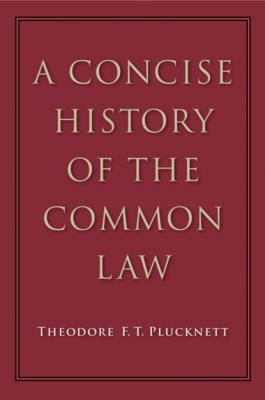A Concise History of the Common Law. Theodore F. T. Plucknett
Читать онлайн.| Название | A Concise History of the Common Law |
|---|---|
| Автор произведения | Theodore F. T. Plucknett |
| Жанр | Юриспруденция, право |
| Серия | |
| Издательство | Юриспруденция, право |
| Год выпуска | 0 |
| isbn | 9781614872474 |
The French Revolution, the long and weary war, and the fearful distress that followed the peace, came near to bringing disaster. Contemporaries felt themselves on the brink of revolution and civil war, and if this last catastrophe was averted it may perhaps have been because the party of privilege and conservatism was so clearly founded on sentiment rather than on political theory. There was no clash of philosophies as there had been in the seventeenth century. Even Benthamism, in spite of the formidable array of logic, ethics and jurisprudence which decorated it, was at bottom as sound common sense as it was dubious philosophy. Benthamism triumphed in spite of its technical apparatus and became merged in the practical good sense of the commercial middle class, avoiding the mysticism of the State as well as the mysticism of the rights of man, just as at the present moment it seems that the political thought which is derived from the common law will again stand aside from the corresponding mysticisms of our own day.
SUMMARY
CHAPTER 1. THE COMMUNAL COURTS
CHAPTER 2. SEIGNORIAL JURISDICTION
CHAPTER 3. THE CROWN AND LOCAL COURTS
CHAPTER 5. THE ORIGINS OF THE CENTRAL COURTS
CHAPTER 6. THE ELABORATION OF THE JUDICIAL SYSTEM: 13071509
CHAPTER 7. THE TUDORS AND THE COMMON LAW COURTS
CHAPTER 8. THE RISE OF THE PREROGATIVE COURTS
CHAPTER 9. PREROGATIVE, EQUITY AND LAW UNDER THE STUARTS
CHAPTER 10. PARLIAMENT AND THE PRIVY COUNCIL
CHAPTER 11. THE COURTS IN THE NINETEENTH CENTURY
CHAPTER 12. THE LEGAL PROFESSION
CHAPTER 13. THE GROWTH OF THE JUDICIARY
CHAPTER 14. PROFESSIONAL LITERATURE
THE COURTS AND THE PROFESSION
SUMMARY
We now come to the history of the law courts and the legal profession. Few matters are more obscure than the early history of our courts, especially of the inferior or local jurisdictions.
THE DIFFERENT SORTS OF COURT
Compared with the courts of Westminster the local tribunals of the county and the hundred are centuries more ancient, and have a past stretching back to pre-Conquest days. Into the great questions of the ultimate origin of the county and the hundred courts, which in the opinion of some writers extends back into Teutonic pre-history, it would be impossible to enter without examining a great deal of technical controversy. Questions equally grave and controversial also obscure the history of those jurisdictions which are commonly called feudal—jurisdictions which competed with, and in one or two cases supplanted, the older institutions. Last of all there came the royal power and the erection of a hierarchy of courts acting in the King’s name, and applying the common law, which in the end superseded all the other jurisdictions. We therefore have, roughly speaking, three main types of courts: the oldest is the communal system represented principally by the county and the hundred; next we have the feudal or seignorial tribunals, of which the court leet is the best-known example; while finally we have the royal courts at Westminster gradually overshadowing all the rest. Within each of these classes there exists the utmost variety, and the further back we trace the history of these courts the more difficult it becomes to make a general statement which shall be approximately true about any of them. The Anglo-Saxon age in particular shows us countless examples of local variance, although it is significant that soon after the Norman Conquest faint signs of order begin to appear.
The remarks that follow, therefore, are only very general observations which will have to be taken subject to a good deal of modification if they are to be fitted into any particular case. Very broadly speaking the threefold division which we have indicated comprises three different classes of courts, each with its own separate type of history; but it is an essential part of that history that each type existed side by side with the others, and therefore was constantly influenced by them. The communal courts are characterised by a territorial jurisdiction coinciding with some administrative district within whose limits their authority extends. The seignorial courts are less definitely territorial in their character; there are occasions when their jurisdiction seems rather to depend upon a personal relationship between lord and tenant. This statement, however, is subject to some reservations since a purely personal jurisdiction of a lord over particular men is very apt, during the middle ages, to become gradually transformed into a jurisdiction over the land of those men. A jurisdiction which was originally personal will therefore become in time territorial, and it is characteristic of this process that such a territory often is of extremely irregular outline; indeed, it is quite common to find that there will be small islands of one jurisdiction scattered at some distance away from the main body. The most plausible explanation of this seems to be that these outlying portions were originally the property of a tenant under a personal jurisdiction, and that in the course of time this personal jurisdiction became territorial.1 Still further confusion between the two types is caused by the constant tendency for old communal jurisdictions (especially the smaller ones) to fall under the domination of some great man and to become in the end his private “franchise”.
ROYAL JURISDICTIONS
Both of these classes of courts, however, differ fundamentally from the third class, the royal jurisdiction. Both of the former were in flourishing condition and apparently equal to the requirements of the nation before the Crown began to intervene. One thing at least is very clear, namely, that the royal courts were intruders upon ground which had been occupied for centuries by older jurisdictions, and
